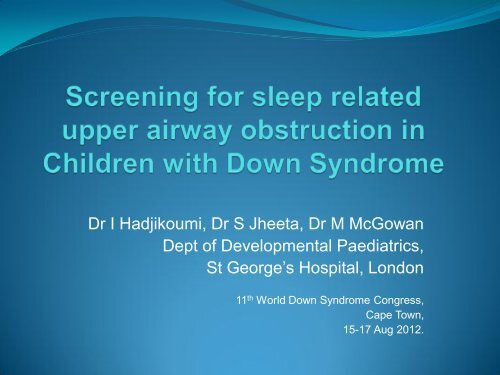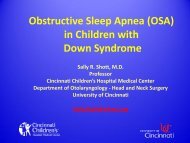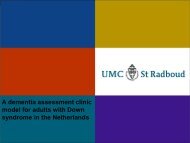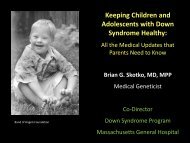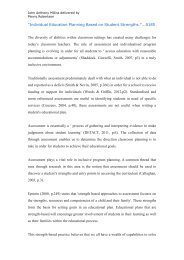here - SBS Documents
here - SBS Documents
here - SBS Documents
You also want an ePaper? Increase the reach of your titles
YUMPU automatically turns print PDFs into web optimized ePapers that Google loves.
Dr I Hadjikoumi, Dr S Jheeta, Dr M McGowan<br />
Dept of Developmental Paediatrics,<br />
St George’s Hospital, London<br />
11 th World Down Syndrome Congress,<br />
Cape Town,<br />
15-17 Aug 2012.
Background Q&A<br />
1. What is it?<br />
2. How common is it?<br />
3. What are the symptoms of obstructive sleep apnoea<br />
(OSA)?<br />
4. Why is it important in Down Syndrome (DS)?<br />
5. Can it be treated?<br />
6. How can we screen and investigate?
What is it?<br />
• Upper airway at the back of the throat becoming<br />
blocked repeatedly during sleep<br />
• When this happens, breathing stops for a short time<br />
• These interruptions in breathing (apnoeas) may<br />
occur hundreds of times during the night causing<br />
sleep disruption and poor quality sleep.
What does it look like?<br />
During sleep:<br />
• characteristic abnormal pauses in breathing<br />
OR<br />
• instances of abnormally low breathing
Symptoms of OSA<br />
• Mouth breathing<br />
• Snoring<br />
• Nocturnal pauses in breathing<br />
• Gasping<br />
• Restless sleep<br />
• Frequent waking<br />
• Extended neck posture on sleeping<br />
• Difficulties in waking in morning<br />
• Daytime sleepiness<br />
• Behavioural difficulties<br />
• Bedwetting<br />
• Poorly controlled epilepsy<br />
• Failure to thrive
How common is it?<br />
• General paediatric population<br />
• 0.7 – 2%<br />
• Down syndrome<br />
• 30-60%<br />
• 97% of those who snore in recent study from Sydney,<br />
Australia
Why is it common in DS?<br />
• Anatomical abnormalities<br />
• Narrow nasopharynx<br />
• Shortened palate<br />
• Midfacial hypoplasia<br />
• Small jaw<br />
• Large tongue<br />
• Generalised hypotonia<br />
• Immature immune system
Co-existing conditions<br />
• Tendency to obesity<br />
• Chronic lung disease<br />
• Gastro-oesophageal reflux<br />
• Congenital heart disease
Consequences of untreated OSA<br />
• Pulmonary hypertension<br />
• Cardiac strain secondary to lung problems<br />
(cor pulmonale)<br />
• Behavioural problems<br />
• Poor academic performance<br />
• Failure to thrive
Screening and Investigation<br />
• Clinical history<br />
• Oximetry- measurement of<br />
blood oxygen levels<br />
• Capnography- measurement<br />
of blood CO2 levels<br />
• Polysomnography- O2,<br />
CO2, eye movements,<br />
airflow, brain activity, chest<br />
movement and video
St George’s Hospital Study Stages<br />
• Stage 1. 2007: Initial study prevalence and<br />
symptoms<br />
• Stage 2. 2010: Repeat study of symptoms and<br />
inclusion of oximetry +/- polysomnography<br />
2009: RCPCH guideline<br />
• Stage 3. 2011: New proforma, all offered oximetry,<br />
capnography +/- polysomnography
Stage 1<br />
• SGH 2007-2009<br />
• To determine prevalence and symptom frequency in<br />
outpatient setting
Retrospective analysis<br />
• 44 patients<br />
• Clinic case notes or telephone questionnaire<br />
• Targeted pulse oximetry for those with 3 or more<br />
symptoms
Questionnaire<br />
• Snoring<br />
• Mouth breathing<br />
• Nocturnal pauses in breathing<br />
• Restless sleep<br />
• Frequent waking<br />
• Extended neck posturing in sleep<br />
• Gasping<br />
• Waking difficulties in the morning<br />
• Daytime somnolence<br />
• Poorly controlled epilepsy<br />
• Failure to thrive<br />
• Enuresis
Results<br />
• 16% - diagnosed OSA by ENT<br />
• Of those without documented symptoms in notes (21/24)<br />
had symptoms identified in telephone questionnaire<br />
• 20% - 3 or more symptoms<br />
• 34% - 1 or more symptoms
Pulse oximetry studies<br />
• 10 studies done<br />
- 8/10 from the 3+symptom group<br />
• All normal<br />
-3/10 had frequent desaturations between 95-97%<br />
Learning points:<br />
• Improve documentation of symptoms<br />
• Oximetry easy to perform, identifies high risk patients<br />
(more than 3 desaturations
Stage 2- repeat questionnaire<br />
• 8 patients with 3 or >3 symptoms contacted with same<br />
questionnaire 12 months later<br />
• 3/8 reported still had >3 symptoms<br />
• These 3 patients referred for polysomnography at<br />
Great Ormond Street Hospital<br />
• All 3 polysomnography reports normal<br />
Learning points:<br />
1. Only 3/8 symptoms persisted after 12 months<br />
2. Questionnaire validity<br />
3. No evidence of OSA in any of patients (0/10)
RCPCH Guideline on Sleep Related<br />
Breathing Disorders 2009<br />
• Clinical history is a sensitive screen but low specificity<br />
• Pulse oximetry is a useful screen but “if positive is highly<br />
predictive, but a negative result does not exclude OSA”<br />
1. All children with DS should be offered screening using as<br />
least pulse oximetry<br />
2. Screen once in infancy and then annually until age<br />
5yrs<br />
3. Children with abnormalities in screening or strong<br />
suspicion of false negatives should then have<br />
polysomnography (oximetry, airflow, effort capnography<br />
and video if possible)
2011: Implementation at SGH<br />
• Following publication of RCPCH guideline, a new<br />
proforma for screening of OSA was implemented<br />
• Clinic checklist modified
New Proforma<br />
3 months 6 months 12 months 2 years<br />
Date: Date: Date: Date:<br />
Exact age: Exact age: Exact age: Exact age:<br />
Growth<br />
Height:<br />
Weight:<br />
Centile<br />
Centile<br />
Vision:<br />
Growth<br />
Height:<br />
Weight:<br />
Centile<br />
Centile<br />
Vision – Clinical<br />
Examination/ Visual<br />
Behaviour<br />
Growth<br />
Height:<br />
Weight:<br />
Centile<br />
Centile<br />
Growth<br />
Height:<br />
Weight:<br />
Centile<br />
Centile<br />
Vision – Full Ophthalmology<br />
Assessment<br />
Neonatal Hearing Screen Full Audiological Assessment Audiology Review<br />
Neonatal TSH Screen<br />
Checked? – Yes/No<br />
Heart<br />
Thyroid Screening<br />
Thyroid Screening<br />
Other Medical Problems: Other Medical Problems: Other Medical Problems: Other Medical Problems:<br />
Areas of Developmental concern Areas of Developmental concern Areas of Developmental concern Areas of Developmental concern<br />
Discuss DLA/Benefits<br />
Formal Notification of SEN to<br />
Education<br />
Symptoms of OSAS Symptoms of OSAS Symptoms of OSAS<br />
Oximetry/ Sleep Studies<br />
Oximetry/ Sleep Studies
Sleep Apnoea Down Syndrome Study<br />
Under 5<br />
History<br />
Telephone<br />
Normal<br />
Questionnaire and<br />
Sleep Study at<br />
Home<br />
With Capnography<br />
(Up to X2)<br />
Low<br />
Suspicion<br />
High<br />
Suspicion<br />
Abnormal<br />
Annual Screen<br />
Joint Respiratory Clinic<br />
ENT Polysomnography Other
Stage 3 – Analysis in Outpatient setting<br />
• Screening
Telephone questionnaire n=10<br />
• 3 patients - no symptoms of OSA<br />
• 7 patients- between 1-9 out of a possible 12<br />
symptoms<br />
• Mean no of symptoms =2<br />
• Commonest symptoms: mouth breathing and<br />
snoring.
All offered Capnography Sleep Study<br />
• 3 x parental declined<br />
• 2x cancelled by parents<br />
n=10<br />
• 5 sleep studies performed<br />
• 5/5 “poor data” and none showed abnormal CO2<br />
levels or desaturations<br />
Learning Points<br />
1. Parents declined, why?<br />
2. Poor quality of results, why?
Equipment used<br />
• TOSCA 500 device<br />
used for home<br />
monitoring<br />
• Cost of machine and<br />
probes approx £4500<br />
• New probes needed per<br />
patient approx £30<br />
applied to earlobe<br />
• Cost of 1x inpatient<br />
admission
Study limitations<br />
• Small numbers<br />
• Nurses/parents not familiar with using the TOSCA<br />
500<br />
• Co-operation difficult in this population<br />
(developmental delay, young age, uncomfortable<br />
probes)
Criteria for a screening programme<br />
• Important health problem<br />
• Well understood natural history of condition<br />
• T<strong>here</strong> should be a detectable early stage<br />
• Early stage treatment more beneficial than late stage<br />
• Test possible in early stage<br />
• The test should be acceptable<br />
• Intervals for repeating the test should be determined<br />
• Adequate health service provision<br />
• The risks, both physical and psychological, should be less<br />
than the benefits<br />
• The costs should be balanced against the benefits<br />
WHO 1968
Does OSA screening in DS fit these<br />
criteria?<br />
• Screening tool technically difficult?<br />
• Uncertainty about treatment<br />
• Natural history of condition not well understood<br />
• Acceptability?
Questions<br />
• Is capnography useful screening tool for OSAS?<br />
• Sensitivity/ specificity of TOSCA 500<br />
• Why were results unobtainable?<br />
• Technique?<br />
• What other tools can be used in screening?<br />
• Devise more reliable scoring system relating to<br />
severity of symptoms<br />
• Cost vs benefit
What is next?<br />
• Accurate scoring of clinical symptoms needed<br />
• Which symptoms have more weight?<br />
• Larger numbers<br />
• Multi centre studies to create best screening tool<br />
• Retrospective study in polysomnography centre<br />
• Study to correlate symptoms, polysomnography<br />
and clinical evolution<br />
• ?Role of sleep nasendoscopy to evaluate<br />
obstruction
Conclusion<br />
- Need for robust data from multi centre studies to<br />
identify best screening tool for OSA<br />
- And if we find a good screening tool, then what<br />
do we do about it?
References<br />
1. Nixon GM, Kermack AS, Davis GM, Manoukian JJ.<br />
Planning Adenotonsillectomy in children with obstructive<br />
Sleep Apnoea: Thee role of overnight pulse oximetry.<br />
Paediatrics. 2004:113: 19-25<br />
2. Caulfield, H. Investigations in paediatric obstructive<br />
sleep apnoea:do we need them? Int Journal of Pediatric<br />
Otorhinolarynogology (2003) 67s1, s107-110.<br />
3. RCPCH Working Party on Sleep Physiology and<br />
Respiratory Control Disorders in Childhood. Sept 2009
Acknowledgements<br />
• Dr R Chavasse- Consultant Paediatric Respiratory Medicine, SGH<br />
• Dr Kilner –Consultant Paediatric Respiratory Medicine, GOSH<br />
• Dr Suzanne Crowley- Consultant Paediatric Respiratory Medicine<br />
• Dr Christos Tzivinikos- ST Paediatrics<br />
• Dr Helen Wolfenden- ST Paediatrics<br />
• Dr Sian Jenkins – ST Paediatrics<br />
• Dr Lauren Filby – ST Paediatrics


